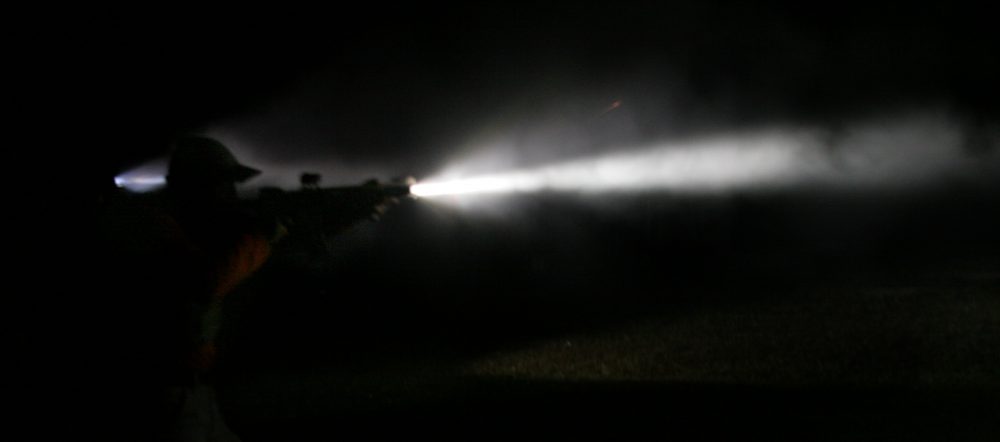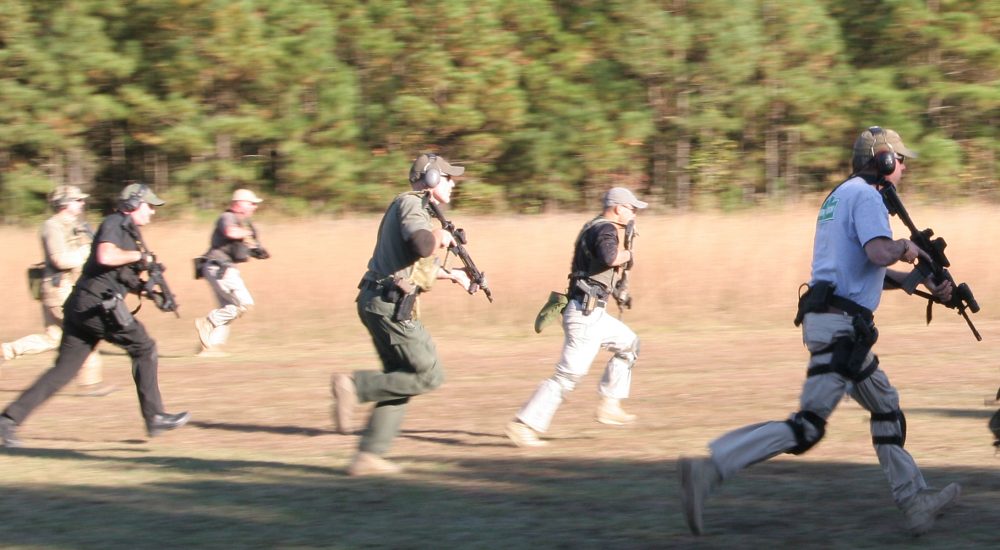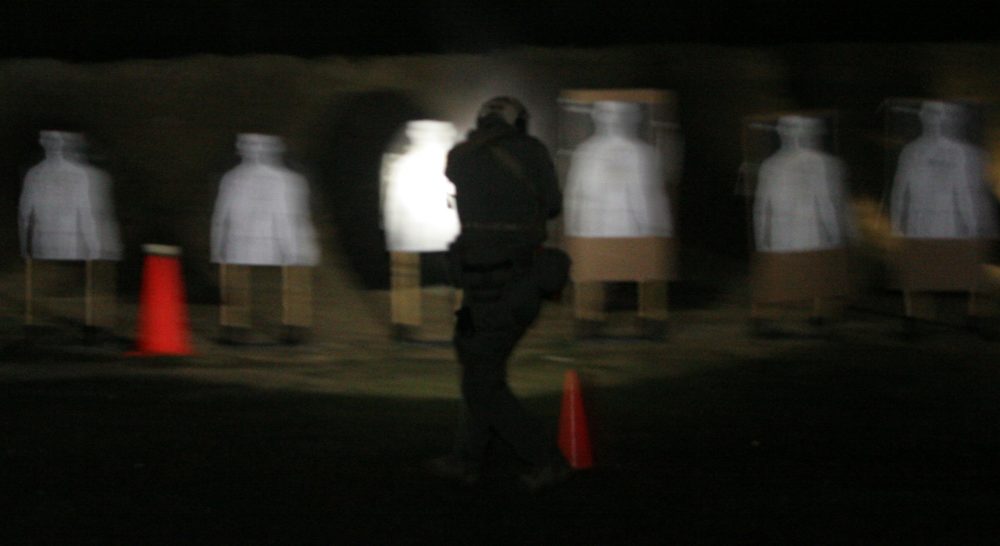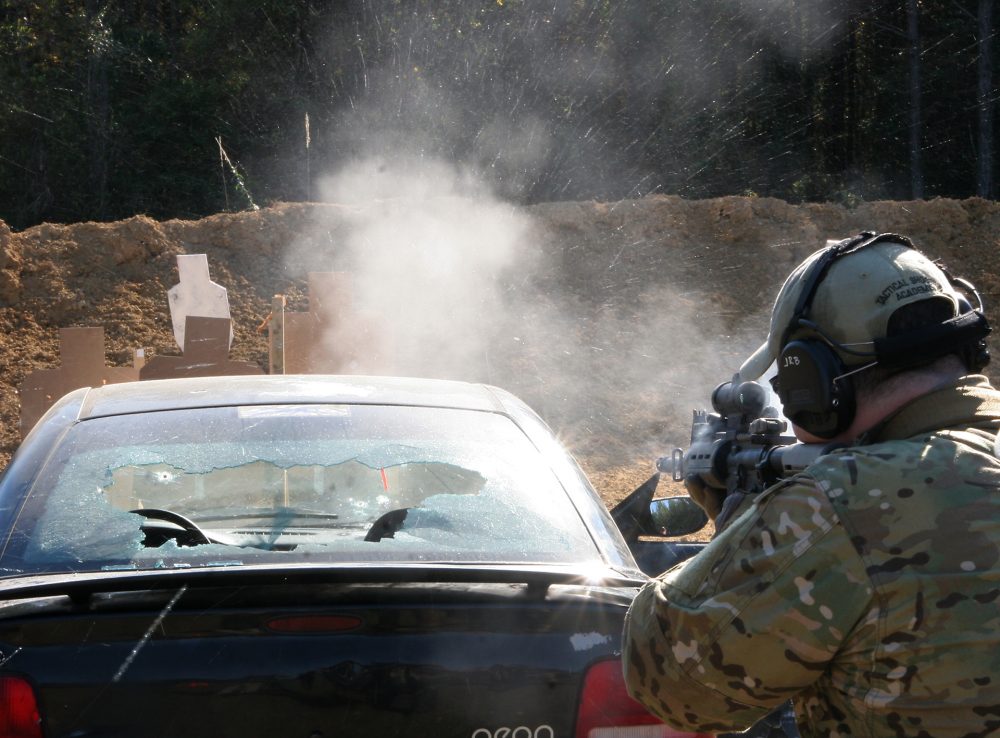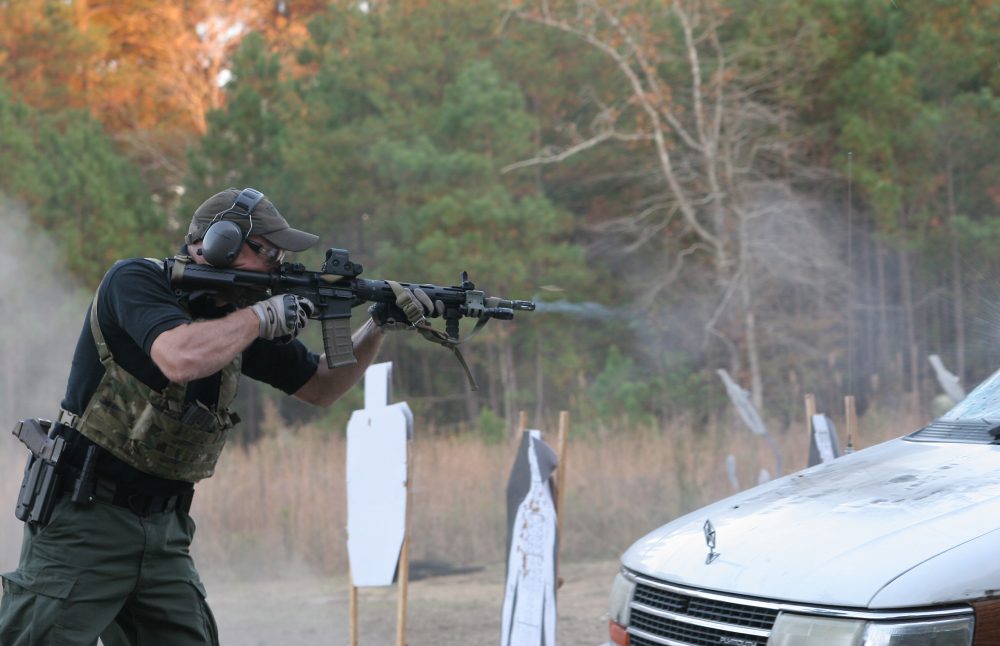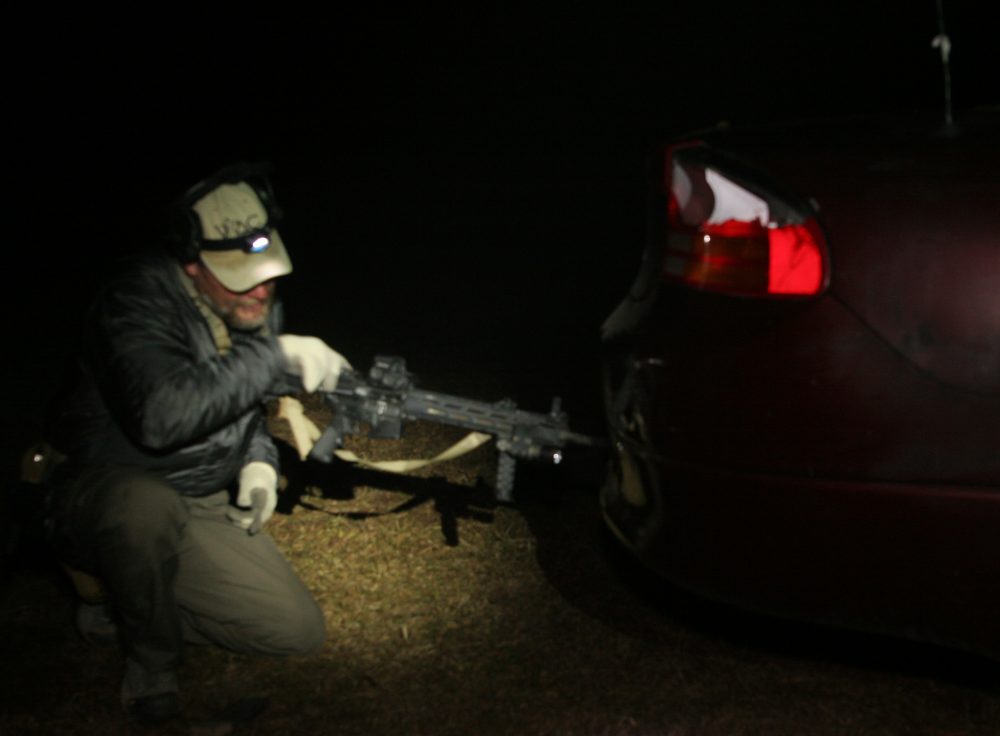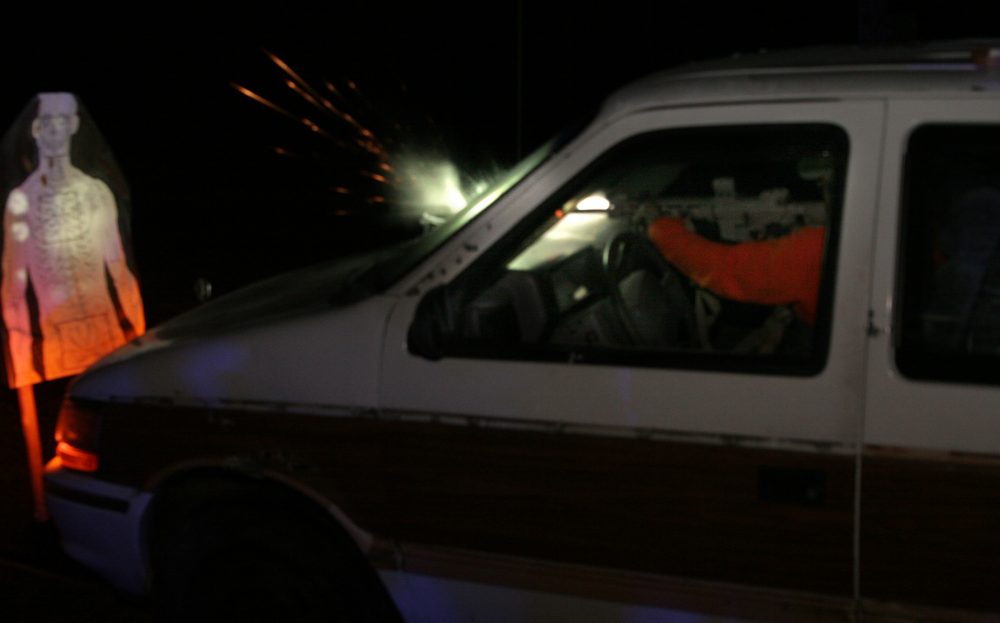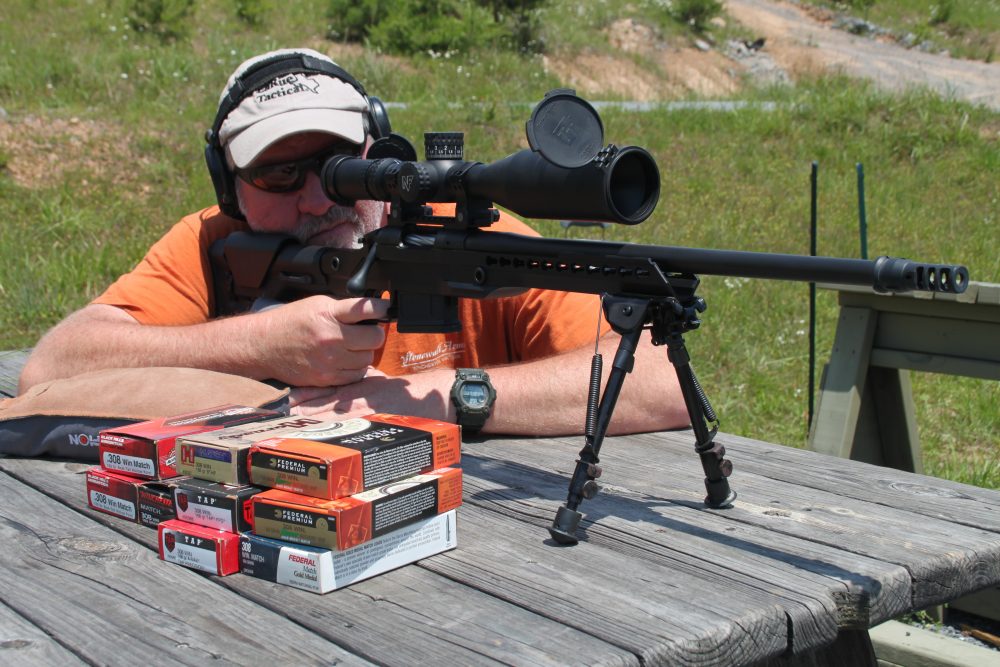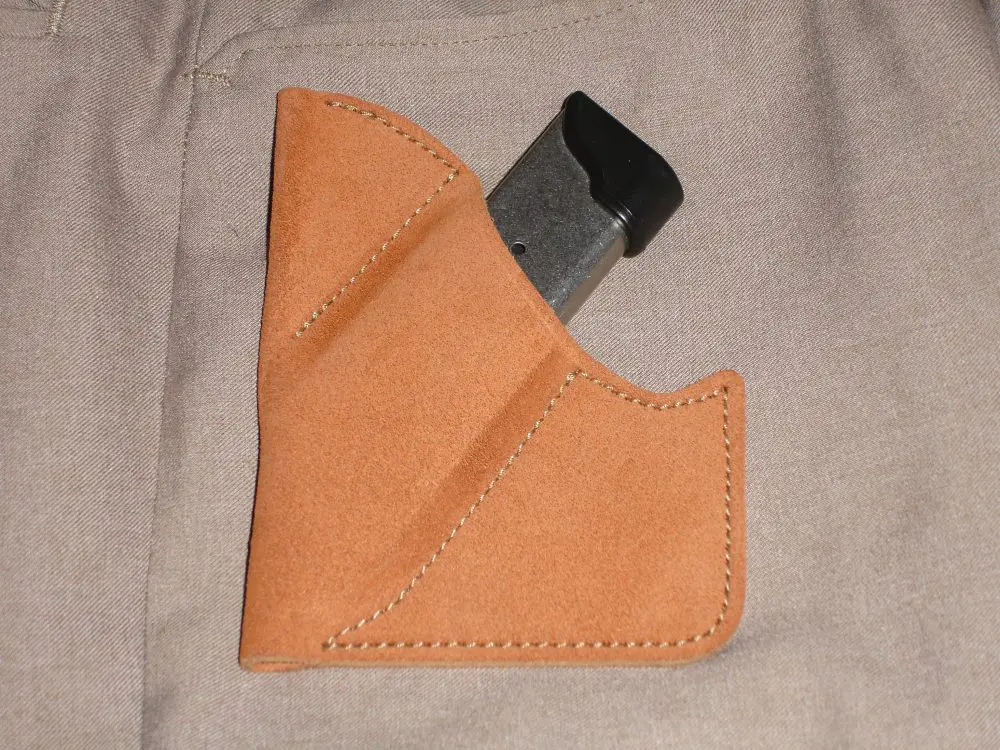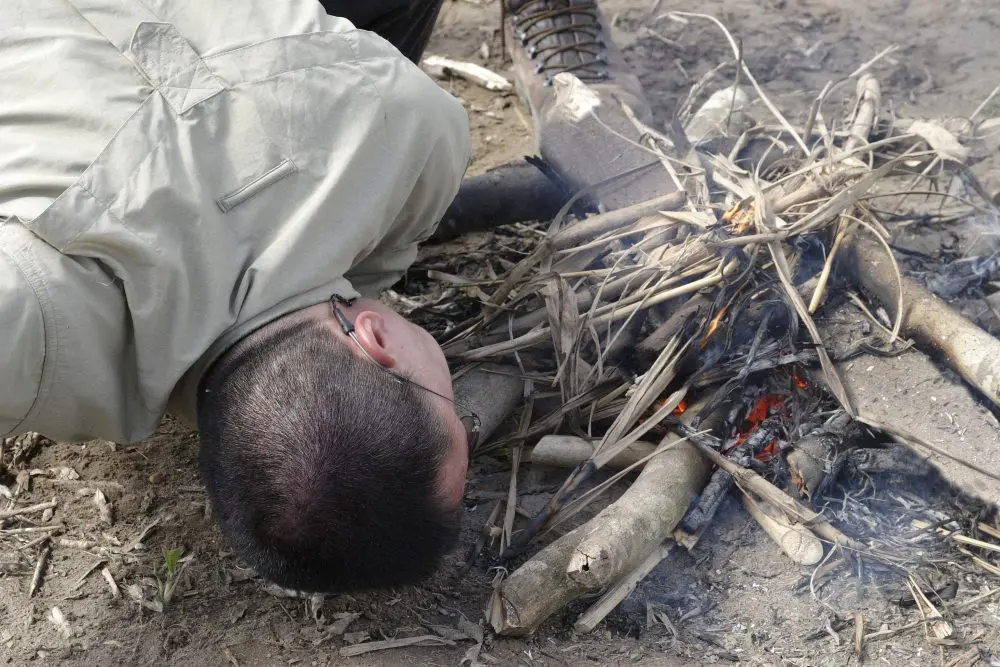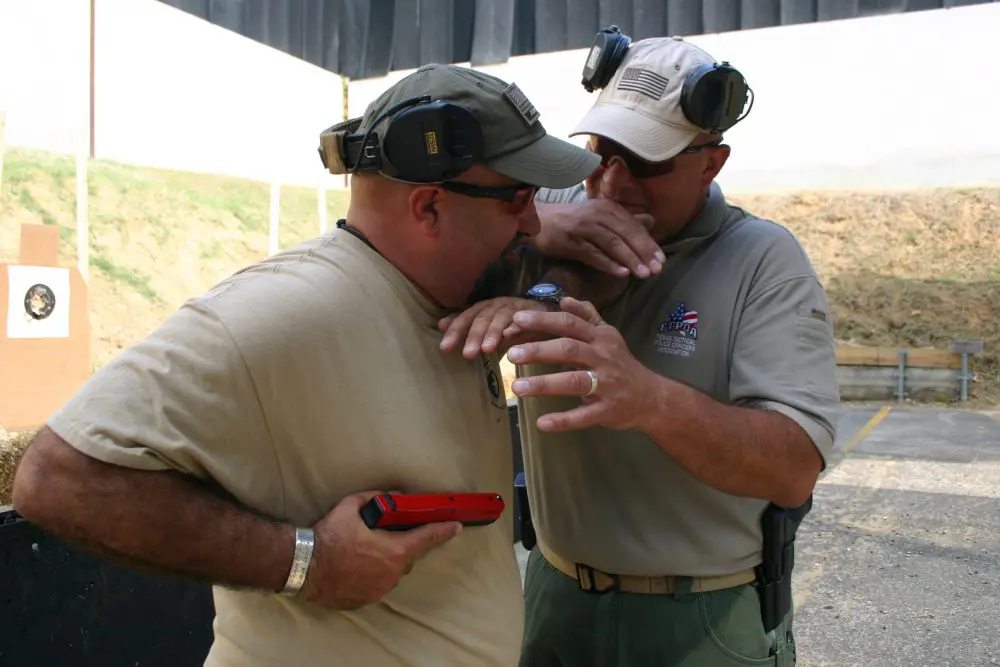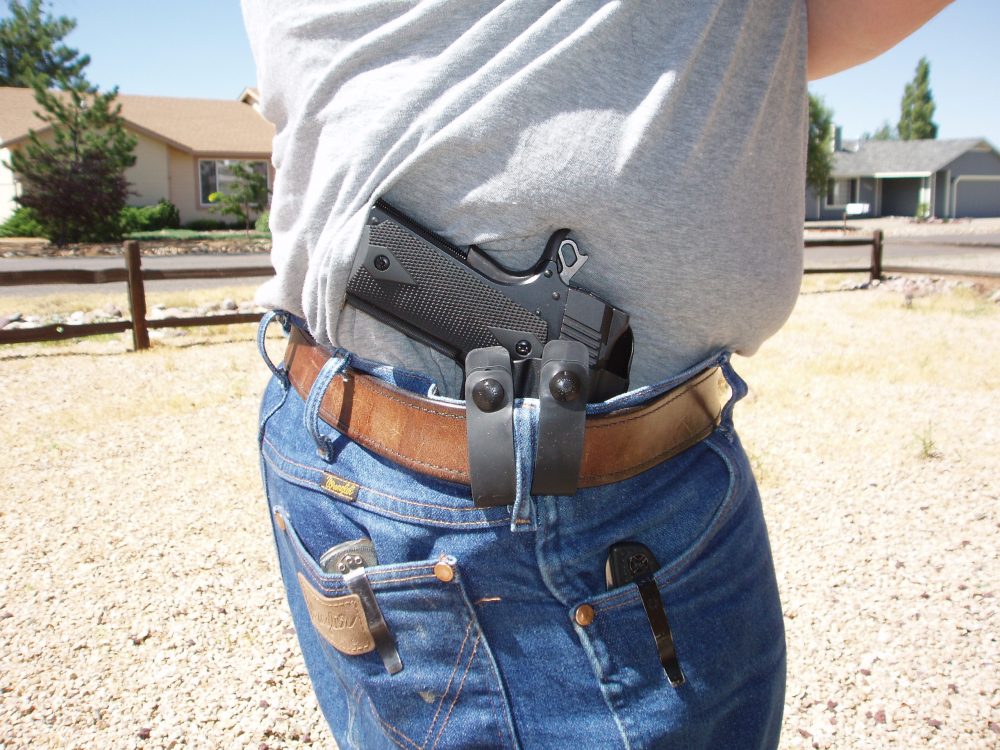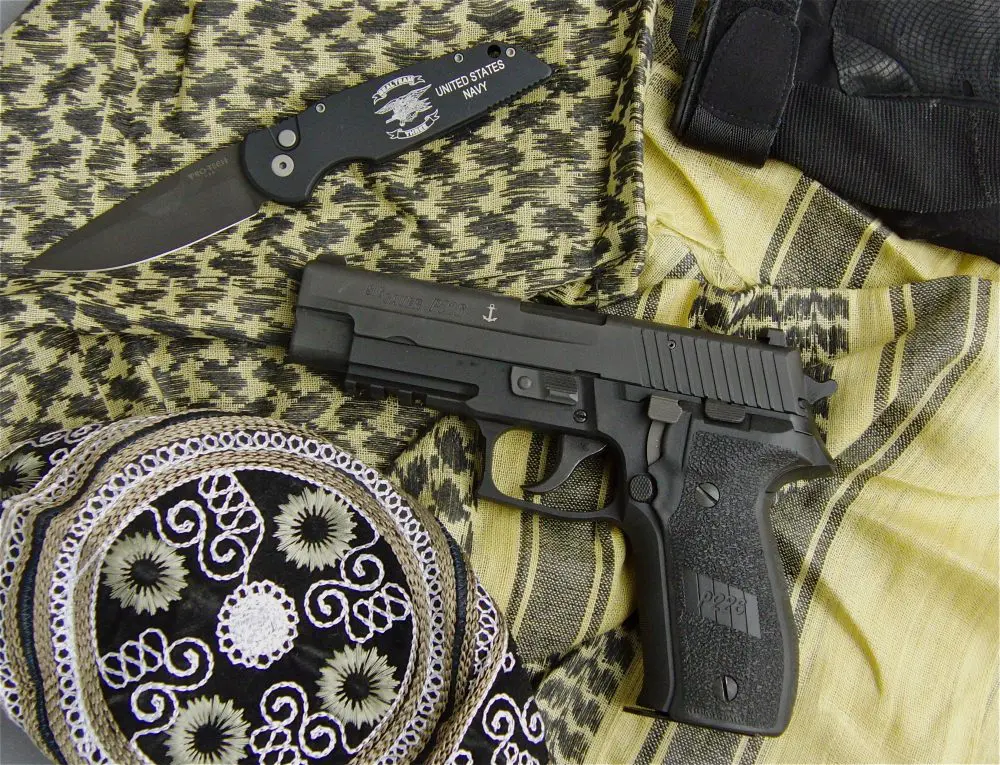Viking Tactics Night Fighter class challenges advanced-level shooters to own the night.
Every so often one finds a training experience that recalibrates the measurement of what is possible and pushes the student past all self-prescribed limits. This is advanced training—and what a group of police, military, and dedicated civilians received at the inaugural Viking Tactics Night Fighter class outside of Fayetteville, North Carolina recently.
The course is designed to train professionals to be completely comfortable fighting in low-visibility scenarios, and VTAC owner/lead instructor Kyle Lamb requires students to be a performing graduate of the 1.5 Carbine class (Viking Invasion, November 2009 S.W.A.T.) or meet screening criteria to ensure that the class is prepared to hit the ground running.
Table of Contents
OVERVIEW
Over the three day/night class, we went from noon until dinnertime, had a chow break and then pushed onward into the darkness for about three to four hours.
On Training Day (TD) 1, the 17 shooters were split into two relays to facilitate portions of the training, while much of the training was station focused, with shooters rotating through vehicles or scenarios. The first day focused on shooting positions, movement and multiples, and then the same principles using white lights after dinner.
Class sprints to firing point during very first drill.
TD2 incorporated clunker vehicles to work in and around from a variety of distances and then, in the dark, the class hit technique-oriented drills followed by scenarios incorporating the vehicles with both pistol and rifle.
The final day pitted the shooters against some intense vehicle scenarios in daylight and low light.
WORLD-CLASS COACHING
Kyle and his assistant instructors (AIs) managed the students’ time superbly and approached the class in a non-traditional manner. There was no lengthy rehash of material or gradual refresher—the student zeroed his carbine and stepped off into the deep end of the pool. Drills that were familiar from the 1.5 class, such as the 100-yard aggregate, were immediately shot to tougher accuracy standards and incorporated a 25-yard run into the original time limits. The drill was then shot support hand, signaling that, while the student worked up to support hand capability in 1.5, he was now expected to perform from the off shoulder on demand.
VTAC’s approach to their high-end instruction is somewhat like a professional athletic trainer: they push you past any limits while also ensuring you maintain proper form and safety. There was minimal head-instructor-to-class “instruction” and maximum trainer-led exercises with coaching tips.
Night of TD1 had shooters engage multiple targets while moving laterally. First evening emphasized all shooting mechanics incorporating use of white light.
They understand, however, that the shooters on the line may have different current capabilities, disparate needs and goals and may require different amounts of interaction or coaching. All shooters were expected to perform at a high level, and an instructor would jump in to get a student individually caught up to the skill being addressed rather than slow the train down.
One aspect that a professional can recognize and appreciate with VTAC classes is the instructors’ grasp of what is possible and how they can push all of the students so far past their preconceived limits and so close to the “wall” without ever letting a shooter get out of control or be unsafe. This can only be accomplished when there is a wealth of experience and capability to draw from. Kyle and Assistant Instructors Tom and Dan have that, plus the ability to recognize exactly where a shooter is on the bell curve.
There was a positive, “you can do this” atmosphere whenever the class was asked to perform a seemingly difficult task. The students in the Night Fighter course responded brilliantly to this, and I saw shooters I had taken previous classes with make tremendous gains in performance.
For example, a drill would require quick hits from 100 yards to a reduced silhouette while shooting covered from the support side. Some students looked furtively left or right to see if this was for real, and when they realized that the instructors expected them to do it—and truly believed they could do it—the steel started ringing with very few extra shots.
Students shot variety of loads through glass and car bodies to determine effects, and took away valuable impressions of how both to apply and defeat cover in vehicle scenarios.
HOW TO DESTROY A CAR IN THREE DAYS
Three vehicles donated their bodies to ballistic research during the class: a compact car, a full-size and a minivan were used to facilitate a wide array of training objectives.
From the kickoff on TD2, the class was working around the vehicles as cover, using many alternate positions to quickly get hits on reduced silhouette and eight-inch steel targets from 100 yards. Having a variety of vehicles parked at different angles and quickly running from one to the other gave students a chance to see what positions they were most effective from in a dynamic environment, while being flexible enough to quickly get into, out of and moving to the next covered position.
Shooters balanced the need for cover and rapid hits with the requirement to clear the muzzle, and the variety of slopes on the vehicles gave shooters some issues, as round after round creased quarter panels until they picked up some of the finer techniques and tweaks that Kyle and crew had demonstrated.
That evening, shooters worked to aggressively gain and use cover around the vehicles while engaging targets at about 20 yards.
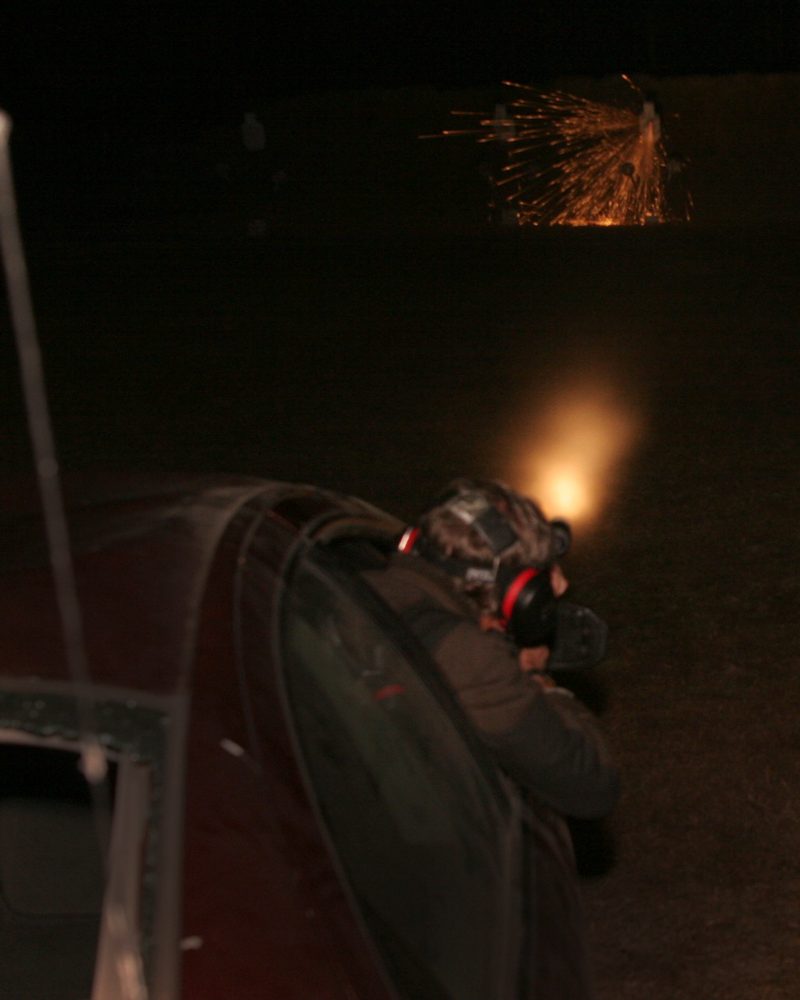
Afterward, the vehicles and targets were repositioned to a traffic stop/bailout scenario, which had the students shooting through open windows to immediate threats and then around and under the vehicles to near targets. This was done both with carbines and pistols. The scenarios quickly exposed any deficiencies in light placement or actuation among the variety of setups in use.
First thing on TD3, the class mustered downrange around a Dodge Neon as Kyle guided the class through a practical demonstration of bullet penetration. A variety of carbine and pistol duty loads were present representing local, state and federal organizations, and each was able to get representative shots through glass, doors and various angles through the vehicle body.
As the glass shards showered into the air, the class got a great idea of what may or may not represent hard cover and what may be required to penetrate and stop a threat in vehicle situations. Several duty loads were disturbingly inadequate and, although Kyle repeatedly warned that one vehicle is an indicator and not an exhaustive test, the students came away with strong impressions of how to better fight through a car to get to a threat or use their own for cover.
Student finishes closing drill at hood of vehicle holding a threat target. Dynamic scenarios had shooters aggressively shooting out of and into vehicles while combining movement with multiple targets.
With the ice broken (so to speak) on shooting into glass and sheet metal, the class rotated through some aggressive scenarios that had the students dealing with instructor-provided problems, then shooting through the windshield to service threats at the hood, and then bailing out to take cover and work some more distant targets. Students went from being awkwardly cramped inside the various cars to manipulating the barrels of their rifles efficiently to get into a firing position.
Short Barreled Rifle shooters held an advantage, but not as much as one might think. The common 14.5- to 16-inch barrels did remarkably well with a little technique and effort not to sweep one’s own legs.
In the waning light, the last daylight drill was a scenario that had shooters pounding across the range, beginning inside one car and fighting their way out and through the other vehicles and some barricades. Nothing gets adrenaline going like leaving a barricade to hammer multiple targets on the move and then closing on a vehicle front, pouring rounds through the windshield into a threat target in the passenger seat!
On the third night, the cars were used in a similar fashion, with white-light scenarios requiring shooters to shoot out of the window and engage targets before disembarking and getting to the rear of the vehicle to address other targets.
The final drill was a swirl of shooting out of and into other vehicles while beat-feeting to cover and addressing targets on the move. It struck me as a remarkably realistic exercise that could be encountered by anyone in the fighting professions.
Kyle Lamb does impromptu demo of how to clear a stoppage in a single hand/injured scenario.
THE FREAKS COME OUT AT NIGHT
I was curious how a mixed-enrollment low-light class would be conducted, as this is among the riskiest live-fire training. There is a reason that low-light training is uncommon in organizational military or law enforcement training. In addition to human reluctance to work after hours, low-light training requires solid safety procedures to mitigate risk and is difficult to administer.
Viking Tactics set benchmarks for safety and realism at the same time without the need for any chem lights, glow vests or anything artificial. Anyone who has conducted low-light training can appreciate how significant this is. The drills were set up to allow each shooter the maximum “dark” to work in, without spill from fellow students illuminating his target area.
One side effect of this was that shooters quickly saw the advantages of different types of lights, beams, and bulbs.
The 60-lumen incandescent bulb, standard just a few years ago, was marginal at best compared to the more powerful, carbine-focused LEDs on some of the rifles. At carbine distances—with the lingering gunsmoke, dust from shot impacts and visual clutter—the wan light from common 60-lumen and pistol-oriented weaponlights did not give users enough visibility to process targets and get immediate hits. The most satisfied shooters seemed to be using LEDs in the 120-lumen range with a tight beam, such as the new VTAC/SureFire light.
Working in the dark forced each shooter to ramp up his situational awareness and be able to confidently work his weapons and gear. Shooters quickly saw the value of being able to work press checks or stoppage clearance without visual cues, since there was no instructor running over with a headlamp to save them, but rather the calm admonishment to “Fix it.”
Ever run a weak-hand-only scenario from a vehicle and move to multiple positions trying to get the light off and on at the appropriate times? It’s tremendously challenging, and the Night Fighter students worked it out and earned some learning points. Light placement is an individual thing, and just about every clock position was in use along the line.
The nighttime scenarios and drills forced shooters to think hard about how accessible their switch/button is from the support side. Most of the shooters who had momentary-only activation on their lights came away resolved to get a “clickie” momentary/on-off tail cap or similar as soon as they returned home.
The extensive hours in the dark across the variety of scenarios presented the shooters with opportunities to meet Murphy that a static firing line night-fire never would. Shooters experienced white-light accidental discharges and learned how to avoid them. Some had the chance to consider secondary light manipulation when their primary lights fizzled. Others had unusually hard stoppages occur only when the sun went down.
Engaging target at vehicle front through windshield. Combination of darkness, vehicles, and challenging target angles/presentations pushed shooters and equipment to perform in face of worst-case realities.
PROVING GROUND
Most shooters who attend high-end training are using the experience to test some part of their kit, and this group was no exception. Rifle-wise, the majority of the class was armed with Smith & Wesson M&P15s of one variety or another—surprising how much market share that brand has gained so quickly. Two shooters used S&W 5.45mm surrogates to great effect, and the distinctive sparks when the commie bullets fragmented against steel were steady evidence of that. The rest of the class was behind a few Colts and a smattering of singletons from most of the familiar names among serious rifles.
In optics, with a single exception it was a red dot show, and the class tilted strongly toward EOTechs and the new XPS in particular, which performed well for all shooters. The right side of the aisle was running Aimpoint products, with the H-1/T-1 continuing to perform out of relation to its size.
The class used a variety of newly arrived, prototype or self-modified accessory items. Several shooters were running the new VTAC extreme battle rail, while others were working out new chest harnesses, sling mounts or support items like the BCM Gunfighter charging handle or the new EAG dump pouch. In a class like this, there is a tremendous amount of experience available among the shooters, and they tend to arrive with proven or promising gear and are happy to exchange the real deal on performance.
Noteworthy problems included an aftermarket bulb turning one of the world’s most reliable lights into a rail ornament, an errant 5.45mm finding its way into a 5.56mm chamber (at night, of course) and effectively “de-milling” the weapon, and Loc-Tite issues with several accessory items disassembling themselves. In each case, the shooters fought their way through and out of the problem and shared the learning points.
My personal gear upheld (or exceeded) all expectations. Rifle used was a Bravo Company BFH mid-length BCM4, which ran like a mad thoroughbred with PMAGs and Black Hills ammo. I was also evaluating a new Safariland ALS holster with my M&P9, which allowed fast open-top access with positive retention.
Knowing that the class was going to be physically demanding and require a lot of work from kneeling, I wore a pair of SKD Tactical Combat Pants. Their athletic cut, well-placed pockets and externally accessible kneepad slots made life better. In lights, I had a Streamlight Poly-Tac LED in a VTAC mount, which gave me a momentary/clickable switch and 120 lumens in a very economical package, while my secondary was a SureFire Outdoorsman with LED bulb.
Comments immediately after the class and, more importantly, after time to reflect, reinforced that the Night Fighter challenged all the students and gave them newfound confidence and heightened skills.
Several shooters remarked that they finally “got” things that they have struggled to grasp or apply in previous instruction. All seemed to have a new benchmark for what is challenging, realistic or advanced. Twelve of every 24 hours in our part of the globe are dark, and the stats show that most violence happens in that span.
The Night Fighter class accomplished an impressive amount in three training days/nights and sent its students onward better prepared to face whatever lurks in the darkness.
SOURCES:
Viking Tactics, Inc.
Dept. S.W.A.T.
3725 Heatherbrooke Drive
Fayetteville, NC 28306
(910) 987-5983
www.vikingtactics.com
Black Hills Ammunition
Dept. S.W.A.T.
P.O. Box 3090
Rapid City, SD 57709-3090
(605) 348-5150
www.black-hills.com
Bravo Company USA, Inc.
Dept. S.W.A.T.
P.O. Box 341
Hartland, WI 53029
(877) 272-8626
www.bravocompanyusa.com
SKD Tactical
Dept. S.W.A.T.
P.O. Box 25
Pacific, MO 63069
(636) 323-4500
www.skdtac.com
SureFire, LLC
Dept. S.W.A.T.
18300 Mount Baldy Circle
Fountain Valley, CA 92708
(800) 828-8809
www.surefire.com

